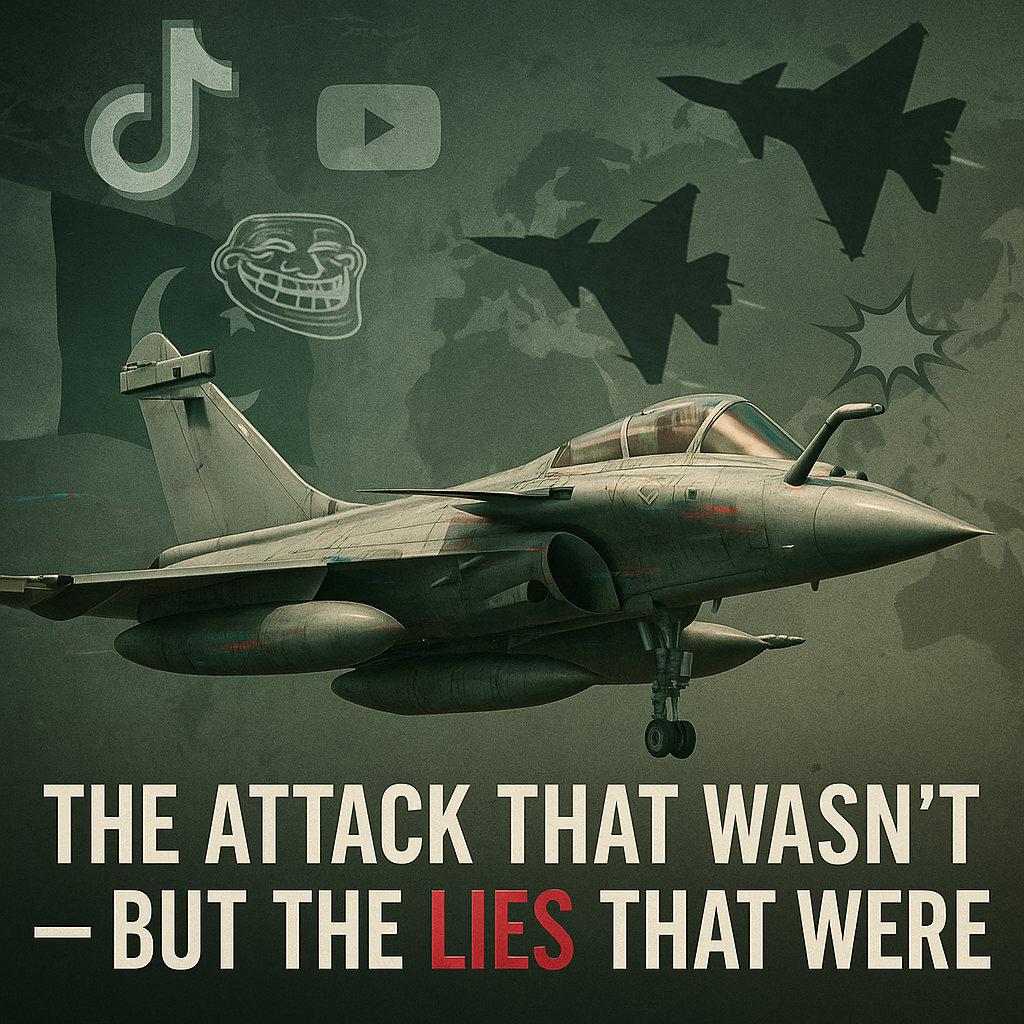India and France now find themselves forced to battle not just enemies in the skies—but shadows on the internet.
🚨 The Attack That Wasn’t – But the Lies That Were
In a whirlwind of allegations, fake footage, and unverified claims, Pakistan and China have launched a high-octane disinformation campaign against the French-built Rafale fighter jet, claiming India’s prized warbird fell embarrassingly to Chinese J-10C jets during India’s May 7 strike inside Pakistan.
According to Pakistani channels and Chinese influencers, three Rafales were downed by PL-15E missiles, launched from Pakistan’s newly equipped Chinese fighters. The story, boosted by memes, TikTok clips, and AI-generated battlefield graphics, claims India’s Rafales were no match for Beijing’s stealthy war toys.
But there’s one glaring hole: no physical proof. No wreckage. No evidence. Just noise.
🤯 China-Pakistan Nexus Targets Rafale’s Reputation
This is no ordinary internet gossip. Analysts inside India’s defense circles say the campaign is engineered, a joint effort between Beijing and Islamabad to cripple the Rafale’s credibility, rattle India’s confidence, and kill French defense deals across Southeast Asia.
In fact, China appears desperate to win regional buyers for its J-10C and J-20 aircraft—but European rivals like Dassault are standing in its way. Enter: narrative warfare.
The central claim of the propaganda: India has lost confidence in the Rafale, and even refused a French technical inspection of its fleet. Fake reports have mushroomed alleging a major fallout between New Delhi and Dassault Aviation, Rafale’s manufacturer. The story? That Indian officials blocked French engineers from examining the jets after the alleged shootdowns—citing “national security.”
France is not amused.
At a press conference in Paris, a spokesperson for France’s defense ministry broke the silence:
“We are in a fog of war… and in the middle of a very intense information war. There are allegations, yes. But there is no confirmation.”
He added that if a Rafale has been lost, it would be the first combat loss ever of the aircraft in its 20-year global history. Notably, no public statement from India has confirmed any such loss.
Dassault Rafale’s Bold Performance Sends Shockwaves Through F-35 and Gripen Markets
🧠 Behind the Smokescreen – What’s Really Going On?
Despite the social media blitz, France remains fully committed to its partnership with India.
India operates 36 Rafales delivered between 2019 and 2022, and in April 2025, signed a new deal for 26 Rafale Marine jets—carrier-capable fighters for INS Vikrant. Far from backing away from the Rafale, India is doubling down.
On June 6, Dassault and Tata Advanced Systems signed a landmark production agreement to manufacture major Rafale components in India. A massive plant in Hyderabad will produce rear fuselage shells and other vital structures. By 2028, India will roll out two full Rafale fuselages per month. Final assembly will remain in France, but the power is shifting east.
And that’s precisely what bothers Beijing.
The Indian Air Force’s $25 billion MRFA project to buy 114 multi-role fighters—open to global bids—is heating up. Rafale is the frontrunner. Dassault’s rivals? Sweden’s Gripen-E, the US-made F-21 and Super Hornet, Eurofighter Typhoon, and Russia’s Su-35. But Rafale has a local advantage—and Chinese disinfo seeks to knock it out.
Macron Rages Against Patriot and F-35 ‘Threat,’ Urges Europe to Buy SAMP/T NG and Rafale
💣 The Real Motive – Markets, Not Missiles
What’s happening here is bigger than one skirmish.
Pakistan’s propaganda is backed by AI-manipulated “combat” videos and recycled footage, made to look like real-time Rafale destruction. These clips have been widely shared, giving the illusion of truth. Chinese platforms then amplify the narrative, turning disinfo into diplomatic damage.
Their goal: not battlefield victory, but market sabotage.
As reported by deftechtimes earlier, Indonesia is eyeing a deal for 42 Rafales worth $8 billion.
Malaysia, the Philippines, and Vietnam are all considering French naval or aerial platforms. If China can turn Rafale into a symbol of failure, it might just push its own jets and ships through the door.
Even in France, alarm bells are ringing. French MP Marc Chavent raised pointed questions in Parliament:
- Was a Rafale truly lost?
- Did the SPECTRA defense system fail against China’s stealth radar?
- Will the next-gen Rafale F5 overhaul its jamming tech to face future threats like the J-20?
These aren’t just military questions—they’re strategic.
🚨 What India Must Watch Now
This isn’t a conflict between aircraft. It’s a war of information, fought with rumors, bots, and AI. India is facing a double attack—military aggression from Pakistan and narrative warfare from China.
The real battlefield is the minds of policymakers and defense buyers across the Indo-Pacific.
Minister Jaishankar’s Paris visit is now more than diplomacy. It’s a counterstrike—to restore truth, confidence, and Rafale’s place in global airpower

